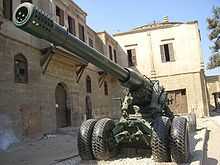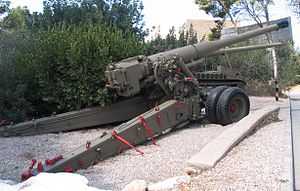180 mm gun S-23
| 180 mm gun S-23 | |
|---|---|
|
S-23 in Beyt ha-Totchan Museum, Zikhron Ya'akov. | |
| Type | Heavy gun |
| Place of origin |
|
| Service history | |
| Used by |
Bulgaria Soviet Union Syria |
| Wars | Syrian Civil War |
| Production history | |
| Designer | NII-58 |
| Designed | 1945–1955 |
| Manufacturer | OAO PO "Barrikady", Volgograd |
| Produced | 1955–1971 |
| Specifications | |
| Weight | 21,450 kg (47,290 lb) |
| Length | 10.48 m (34 ft 5 in) with barrel withdrawn for transport. |
| Barrel length | 8.8 m (28 ft 10 in) |
| Width | 2.99 m (9 ft 10 in) |
| Height | 2.62 m (8 ft 7 in)[1] |
| Crew | 16[1] |
|
| |
| Shell | HE, Nuclear-capable[1] |
| Caliber | 180 mm (7.1 in) |
| Breech | interrupted screw |
| Carriage | split trail |
| Elevation | -2° to +50° |
| Traverse | 44° |
| Rate of fire |
1 rpm maximum; 1 round every two minutes sustained[1] |
| Muzzle velocity | 850 m/s (2,800 ft/s)[2] |
| Effective firing range | 30.4 km (18.9 mi)[1] |
| Maximum firing range |
43.8 km (27.2 mi) with RAP[1] |
| Sights | S-85 mechanical sight, PG-1M panoramic sight and MVShP direct sight |
| Wikimedia Commons has media related to S-23 180 mm gun. |
The 180 mm gun S-23 (Russian: 180-мм пушка С-23) was a Soviet heavy gun of Cold War era. It was developed in the early 1950s, with the design based on naval guns. Its first public appearance was the 1955 May Day parade in Moscow.[1] For some time, it was believed in the West that the S-23 was actually a 203mm weapon, and as a result it was often referred to as the 203 mm M1955 gun howitzer. However, after an example was captured in the Middle East during the 1970s this misconception was dispelled.[2]
Design history
The S-23 was designed by NII-58 as part of a new series of heavy artillery systems consisting of the following types:
- the 180 mm gun S-23;
- a 210 mm howitzer S-23-I a.k.a. S-33;
- a 280 mm mortar S-23-II a.k.a. S-43 and
- a 203 mm gun howitzer S-23-IV.
All were to be based on the same carriage. The order to start series production was given but after the production of seven S-23s (GRAU index: 52-P-572), one S-33 and one S-43 by PO "Barrikady" in 1955 the project was cancelled.[3] The seven guns remained in service until 1967 and were regularly shown during the annual May Day parades, being towed by AT-T artillery tractors. At the request of Syria, who needed a large-calibre gun system, the project was shortly revived at the end of the 1960s and twelve more S-23 guns were produced in 1971, as well as the new VOF28 round with RAP projectile OF43. The other rounds were the VF-572 with HE projectile F-572 and the VG-572 with concrete-piercing projectile G-572.[4]

Operational history
The West assumed that the S-23 was issued within the Soviet Army at a ratio of 12 weapons per heavy artillery brigade. It was exported to Syria and some sources suggest that it might have been exported to other Middle Eastern countries such as Egypt and Iraq, and likely the Indian Army.[2]
External links
- S-23 at Mega.km.ru (Russian)
- S-23 series at RussianArms.ru (Russian)
Sources
- Shirokograd A.B. (2000) - Entsiklopediya otechestvennoj artillerii - Harvest
References
- ↑ 1.0 1.1 1.2 1.3 1.4 1.5 1.6 "S-23". www.militaryfactory.com. Archived from the original on 12 October 2008. Retrieved 2008-10-13.
- ↑ 2.0 2.1 2.2 "180 mm ammunition for Russian S-23 gun, Field artillery". Janes Defense Website. Retrieved 2011-06-03.
- ↑ Shirokograd A.B. (2000) - Entsiklopediya otechestvennoj artillerii - Harvest
- ↑ http://www.russianarms.ru/forum/index.php?topic=3530.0
